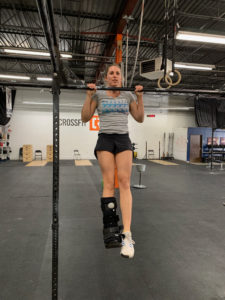Athletes will suffer tweaks and injuries from time to time. Many athletes struggle with the give and take nature of recovering from an injury.
The coach’s job is to provide a voice of reason, keep an eye on long term recovery, and hold the athlete back when needed.
The situation is all too familiar to many coaches. The athlete suffers a knee injury and receives the recommendation to take 6-weeks off from certain exercises to allow the knee to heal. While the athlete receives excellent modifications from coaches that preserve the intensity of the workout yet, in the moment, it can be hard for some athletes to let go of the fact that they’re not going to do the workout as it was written that day.
Many athletes struggle with the give and take nature of recovering from an injury. The coach’s job is to provide a voice of reason, keep an eye on long term recovery, and hold the athlete back when needed.
Here are a number of questions you can ask your athlete to help them arrive at the best decision for them for that day.
-
What are the movements you were told not to do?
Use this question when you see an athlete attempting to warm-up a movement you know they should not do. While it’s rhetorical in nature, it helps the athlete take ownership of their role in the process.
rhetorical in nature, it helps the athlete take ownership of their role in the process.
In our example above, the athlete received a list of movements to avoid for the 6-week period, mostly involving dynamic jumping and squatting patterns. The workout for the day involves dumbbell front squats. You see the athlete warming up with squats. While you know the athlete is not supposed to do squats, you ask them what movements they were to avoid to reinforce their decision-making process. When they comment they are not supposed to do squats, have another movement option ready to go for them.
-
What are the total reps you’ve done of that movement since your injury?
As athletes begin to bring a movement back into the mix, they will often do it once, with little or no load, but then attempt to double the weight or volume the next time! As athletes come back, aim to increase the rep volume by 15% each time. Indicate to athletes that their checkpoint after each increase should be that there was no residual pain the next day. If there is, this is an indicator that the area still needs more time to heal.
-
Is it a pain-free range of motion?
This is my personal favorite question to ask athletes recovering from an injury. Deep down, athletes have a great sense of whether they should or should not be doing a movement. This question helps bring the answer to the surface and direct what they should or should not do.
Oftentimes athletes will respond to this question with, “No, it’s not really pain-free, but I think I can get through it ok.”
This answer is not ok! Either the athlete needs more time to heal or there is another issue that needs to be addressed.
In instances where you have to utilize the questions above to help the athlete make a good decision, be sure to follow-up with them after class. Indicate that you’re there to help them recover and make good decisions along the way.
How do you work with athletes who come to class and need to modify for injury? Post to comments.
Read more on coach and athlete interactions here!